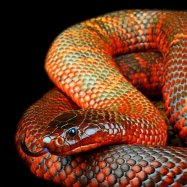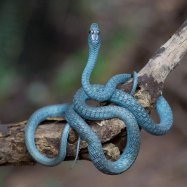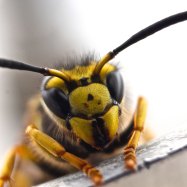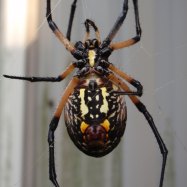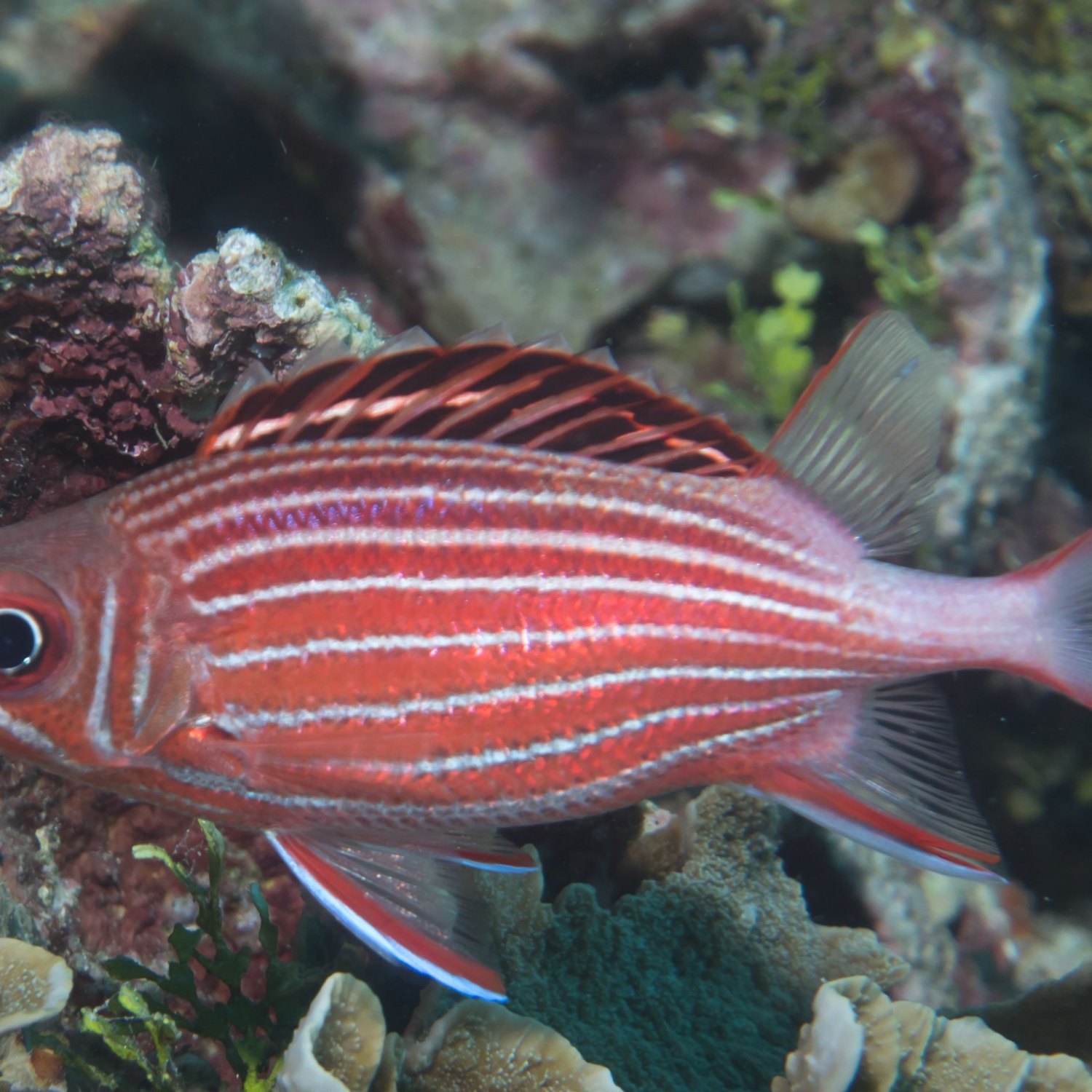
Squirrelfish
Up to 14 inches
Squirrelfish are a type of colorful, tropical fish found in the Caribbean Sea. These stunning creatures belong to the Holocentridae family and can grow up to 14 inches in length. With their laterally compressed body shape, they are able to maneuver through coral reefs with ease. Keep an eye out for these striking fish on your next dive in the Caribbean! #Squirrelfish #CaribbeanSea #Holocentridae
Animal Details Summary:
Common Name: Squirrelfish
Kingdom: Animalia
Habitat: Reef-associated; non-migratory
The Fascinating World of Squirrelfish: Exploring the Unique Characteristics of Holocentrus adscensionis
When we think of the ocean, we often think of beautiful, vibrant coral reefs and the colorful fish that populate them. And among these fish, there is one particular species that stands out - the squirrelfish. With its striking reddish-orange body coloration and unique body shape, the squirrelfish is a fascinating creature that can be found in the Western Atlantic Ocean. Let's dive into the world of squirrelfish and explore its unique characteristics, behavior, and habitat Squirrelfish.A Brief Introduction to Squirrelfish
Scientifically known as Holocentrus adscensionis, the squirrelfish is a member of the Holocentridae family and can be found in the waters of the Western Atlantic Ocean. Its common name, squirrelfish, is derived from its large eyes that resemble those of a squirrel. This fish is also commonly referred to as the longjaw squirrelfish, due to its large jaws compared to other members of its family.Classification of Squirrelfish
As we delve deeper into understanding the unique characteristics of the squirrelfish, it's essential to understand its classification within the animal kingdom. The squirrelfish belongs to the Class Actinopterygii, which consists of ray-finned fishes. Its order is Beryciformes, which includes species with spiny rays on their fins, and its family is Holocentridae, which comprises of squirrelfish and soldierfish.The Habitat of Squirrelfish
Squirrelfish are reef-associated and non-migratory species, meaning they prefer to stick to particular areas and are not known for long-distance movement. They can be found in the Western Atlantic Ocean, particularly in the waters around the Caribbean Sea. These fish are usually found in areas with a rocky bottom, coral reefs, and underwater caves, where they can hide during the day and come out at night to hunt Sea Trout.Coloration and Body Shape of Squirrelfish
One of the most striking features of the squirrelfish is its red-orange body coloration. This color is not just for show; it serves as a protective mechanism, helping them camouflage themselves among the coral reefs. This reddish hue absorbs blue light, making them less visible to potential predators.In addition to their coloration, squirrelfish also have a laterally compressed body shape, which means their bodies are flattened from side to side. This helps them fit into tight spaces and maneuver through coral reefs with ease.
Feeding Habits of Squirrelfish
Squirrelfish are carnivorous and feed on a wide variety of prey, including crustaceans, small fish, and shrimp. They are nocturnal hunters, and their large eyes are adapted to see in low light conditions, making it easier for them to hunt at night. These fish use their sharp teeth to capture and crush their prey.Further, their highly developed lateral line system, which senses vibrations and changes in water pressure, helps them detect prey in the dark. Squirrelfish also have a unique feeding strategy where they use their pectoral fins to flush out prey hidden in the sand, making them one of the few fish species to use their fins in this way.
Geographical Distribution and Country of Origin
As mentioned earlier, squirrelfish can be found in the Western Atlantic Ocean, particularly in the Caribbean Sea. They also inhabit the waters of Florida, USA. However, they are not native to the United States and are believed to have originated from the tropical waters around the Bahamas and Bermuda.Unique Adaptations of Squirrelfish
Squirrelfish have several remarkable adaptations that have enabled them to thrive in their reef-dwelling habitats. Let's explore some of their most unique characteristics in more detail.Adaptations for Low Light Conditions
As mentioned earlier, squirrelfish have highly developed eyes adapted for low light conditions, making them excellent nocturnal hunters. These eyes also have a reflective layer called a tapetum lucidum, which maximizes the sensitivity to any available light, allowing the fish to see even in extremely dim conditions.Protective Body Coloration and Defense Mechanisms
The reddish-orange coloration of squirrelfish not only helps them blend in with their surroundings, but it also serves as a protective mechanism against predators. Additionally, if threatened, squirrelfish can release a loud grunting sound and lock their fins in position, making them challenging to remove from the reef.Ability to Change Color
Squirrelfish have the unique ability to change their coloration based on their surroundings. This adaptation can be seen when they move from brightly-lit areas to darker ones, where they can appear more pale and pale red. This color change helps them maintain their camouflage while moving through different environments.Symbiotic Relationships
One of the most unique adaptations of squirrelfish is its ability to form symbiotic relationships with other organisms. They are often seen cleaning other fish, such as groupers and snappers, by eating the parasites on their skin. They also form symbiotic relationships with cleaner wrasses, where they allow the wrasses to clean their gills and mouth in return for protection.Reproduction and Lifecycle
Squirrelfish have an interesting reproductive cycle, where male fish attract females by extending their brightly colored fins and making grunting sounds. Once the female lays her eggs, the male guards them until they hatch, which can take up to 10 days. After hatching, the larval squirrelfish spends several months in the open ocean before settling on a reef.The Importance of Squirrelfish in the Ecosystem
Squirrelfish play an essential role in maintaining the balance of coral reef ecosystems. As predators, they help control the population of other species, maintaining the health of the reef. They also contribute to nutrient cycling by consuming and depositing organic material into the reef ecosystem.Additionally, as night-time hunters, squirrelfish prevent the overgrowth of algae, which can smother and damage coral reefs. This makes them an essential part of the coral reef community and a key species in maintaining the delicate balance of these ecosystems.
In Conclusion
In conclusion, the squirrelfish is a unique and fascinating species that has adapted to thrive in its reef-dwelling habitat. Its striking coloration, body shape, and hunting habits make it stand out among other fish species. By understanding and appreciating the distinct characteristics of squirrelfish, we can better protect and preserve these incredible creatures and the fragile ecosystems they call home.

Squirrelfish
Animal Details Squirrelfish - Scientific Name: Holocentrus adscensionis
- Category: Animals S
- Scientific Name: Holocentrus adscensionis
- Common Name: Squirrelfish
- Kingdom: Animalia
- Phylum: Chordata
- Class: Actinopterygii
- Order: Beryciformes
- Family: Holocentridae
- Habitat: Reef-associated; non-migratory
- Feeding Method: Carnivorous
- Geographical Distribution: Western Atlantic Ocean
- Country of Origin: United States
- Location: Caribbean Sea
- Animal Coloration: Reddish-orange body coloration
- Body Shape: Laterally compressed
- Length: Up to 14 inches
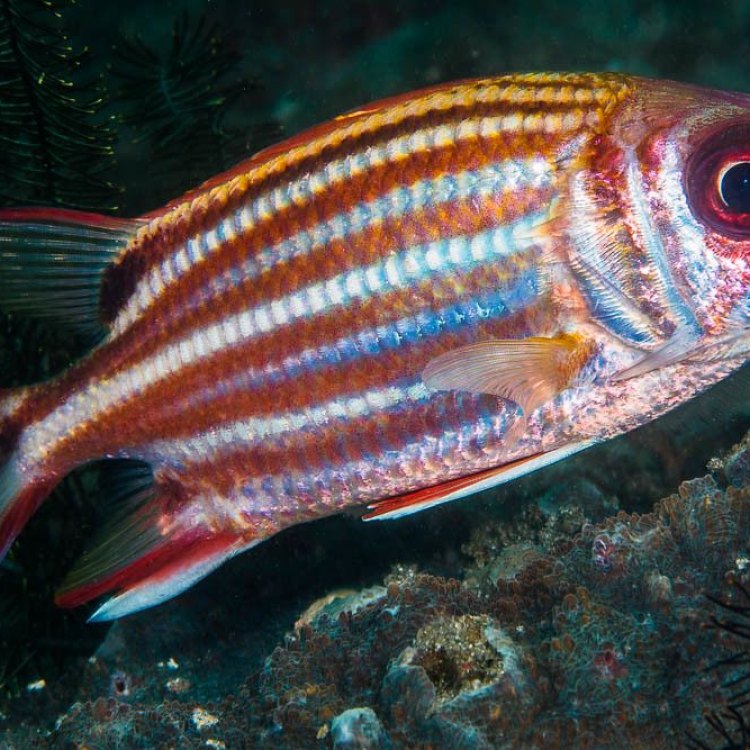
Squirrelfish
- Adult Size: 6 to 8 inches
- Average Lifespan: 8 to 10 years
- Reproduction: Oviparous
- Reproductive Behavior: Spawning
- Sound or Call: Grunting sounds
- Migration Pattern: Non-migratory
- Social Groups: Solitary or form small groups
- Behavior: Nocturnal
- Threats: Overfishing, habitat degradation
- Conservation Status: Least Concern
- Impact on Ecosystem: Important prey for larger predators
- Human Use: Popular aquarium fish
- Distinctive Features: Large eyes, large mouth, sharp spines
- Interesting Facts: They have a unique ability to change color at night.
- Predator: Bigger predatory fish
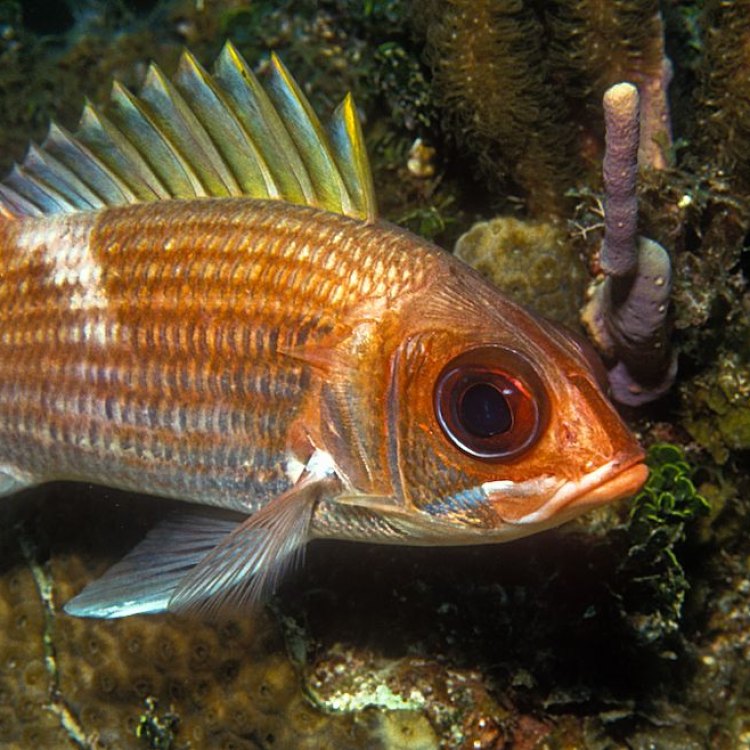
Holocentrus adscensionis
The Fascinating World of Squirrelfish
The world's oceans hold a vast and diverse array of life, from tiny plankton to massive whales. However, some of the most intriguing creatures can be found in the overlooked and often underestimated category of fish. One such fish that captures the attention of marine enthusiasts and scientists alike is the Squirrelfish.With its distinctive features, interesting behavior, and vital role in the ecosystem, the Squirrelfish is a species that demands further exploration and appreciation PeaceOfAnimals.Com. In this article, we will delve into the world of Squirrelfish, learning about its unique characteristics and how it contributes to the underwater ecosystem.
The Physical Characteristics of Squirrelfish
The Squirrelfish belongs to the genus Holocentrus, a group of nocturnal fish found in the tropical and subtropical waters of the Atlantic, Pacific, and Indian Oceans. They are easily recognized by their large, saucer-like eyes, which are adapted for low light conditions, and their sharp spines that line their body.These fish are relatively small, measuring between 6 to 8 inches in length. However, what they lack in size, they make up for in their striking appearance. Their body is typically reddish-orange, with a silvery white belly, and covered in a mosaic of dark scales. This coloration not only makes them stand out in the underwater world, but it also serves as a form of camouflage. During the day, Squirrelfish blend in with the colorful coral reefs, and at night, their bright coloration fades into the dark ocean depths.
One interesting physical feature of the Squirrelfish is its ability to change color at night Spitting Cobra. It has specialized light-sensitive cells, called chromatophores, which enable it to adjust its coloration to match its surroundings and remain hidden from predators. This remarkable adaptation allows the Squirrelfish to be active and hunt at night without being detected by larger predatory fish.
Reproductive Behavior and Lifespan
Squirrelfish are oviparous, meaning they reproduce by laying eggs. However, unlike some fish species, males play an active role in caring for the eggs. After a spawning event, the male will guard and aerate the eggs until they hatch. Once hatched, the young Squirrelfish will remain near the surface for protection until they are fully developed.The average lifespan of a Squirrelfish is between 8 to 10 years, although they can live longer in captivity. During this time, they are relatively solitary, preferring to hide in crevices or under coral during the day and actively foraging for food at night.
The Fascinating Behavior of Squirrelfish
As mentioned earlier, Squirrelfish are primarily nocturnal, meaning they are most active at night. This behavior is an adaptation to avoid predators, as many of their predators are diurnal (active during the day). At night, they can move about freely and hunt without worrying about being seen.Another interesting behavior of the Squirrelfish is its grunting sounds. These sounds are produced by the rubbing of their teeth against a bony plate in their throat. The purpose of these sounds is still unknown, but it is believed that they may be used for communication or to attract a mate.
Squirrelfish are also known to form small groups, although they are predominantly solitary. They do not have a strict hierarchical social structure, and the groups can consist of individuals of varying sizes and ages. These groups are likely formed for protection and foraging purposes, as there is safety in numbers in the vast and unpredictable ocean.
Threats to Squirrelfish and Conservation Status
Unfortunately, Squirrelfish face several threats in the wild. Overfishing is a significant issue, as they are a popular aquarium fish due to their vivid colors and unique appearance. Their popularity in the aquarium trade has led to a decline in wild populations, especially in areas where they are heavily targeted.In addition to overfishing, habitat degradation also poses a threat to Squirrelfish. As coral reefs, their main habitat, continue to suffer from the effects of climate change and pollution, the Squirrelfish and other reef inhabitants are left with dwindling resources and shelter.
Despite these threats, the Squirrelfish is currently listed as 'Least Concern' on the IUCN Red List, the world's most comprehensive inventory of the global conservation status of animal and plant species. This is due to its widespread distribution and relatively stable population. However, continued monitoring and conservation efforts are necessary to ensure their long-term survival.
The Important Role of Squirrelfish in the Ecosystem
Like many fish species, Squirrelfish play a crucial role in the ocean's ecosystem. They are an important prey species for larger predators, such as barracudas and groupers. Without Squirrelfish, these predators would have a significant gap in their diet, potentially causing disruption to the delicate balance of the food web.Furthermore, Squirrelfish also contribute to the health of coral reefs. As they feed on small invertebrates and algae, they help control the growth of these organisms, keeping the reef healthy and preventing overgrowth that could smother the coral. With their specialized teeth, Squirrelfish can even remove parasites from other fish, contributing to overall reef cleanliness.
Human Use of Squirrelfish
Apart from being popular in the aquarium trade, Squirrelfish also have a long history of human use as a food source. In some regions, they are considered a delicacy and are often sold in local markets. Due to their small size, Squirrelfish are usually caught using traditional methods, such as handlines and traps, making them a sustainable option for human consumption.Squirrelfish also have cultural significance in some societies. In Hawaii, the fish is associated with a Hawaiian god and is considered a symbol of courage, fearlessness, and strength.
The Intriguing Predators of Squirrelfish
As mentioned earlier, Squirrelfish have a few predators, such as larger fish species. But they also have an interesting relationship with one particular predator – Moray eels. Moray eels are known to prey on Squirrelfish, but interestingly, young eels are often observed living among schools of Squirrelfish. This behavior is thought to provide the young eels with protection and an abundant food source.The Future of Squirrelfish
Squirrelfish may not be a widely recognized or iconic species, but they are undoubtedly fascinating and play a crucial role in the ocean ecosystem. While threats to their survival exist, steps are being taken to protect them and their coral reef homes. Through sustainable fishing practices, conservation efforts, and raising awareness, we can ensure that generations to come will have the opportunity to appreciate these unique and vital fish.In conclusion, the world of Squirrelfish is full of surprises and intriguing features. From their ability to change color at night to their important role in the ocean ecosystem, these fish have captured the attention of scientists and aquarists alike. By learning more about these fascinating creatures, we can better appreciate the diversity and complexity of life in the oceans and the importance of protecting it for the future. So, the next time you see a Squirrelfish in an aquarium or on a coral reef, take a moment to marvel at its distinctive features and remember its vital role in the underwater world.
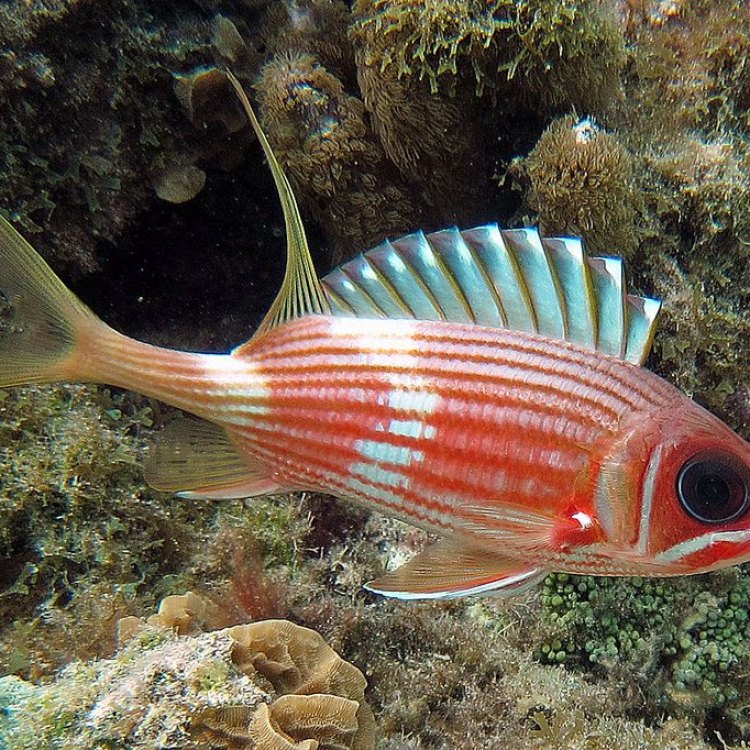
The Fascinating World of Squirrelfish: Exploring the Unique Characteristics of Holocentrus adscensionis
Disclaimer: The content provided is for informational purposes only. We cannot guarantee the accuracy of the information on this page 100%. All information provided here may change without prior notice.

